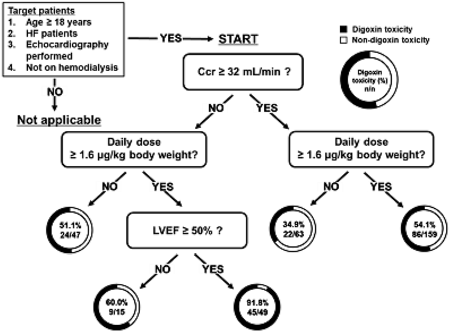15 0 0 0 OA Machine Learning-Based Prediction of Digoxin Toxicity in Heart Failure: A Multicenter Retrospective Study
- 著者
- Yuki Asai Takumi Tashiro Yoshihiro Kondo Makoto Hayashi Hiroki Arihara Saki Omote Ena Tanio Saena Yamashita Takashi Higuchi Ei Hashimoto Momoko Yamada Hinako Tsuji Yuji Hayakawa Ryohei Suzuki Hiroya Muro Yoshiaki Yamamoto
- 出版者
- The Pharmaceutical Society of Japan
- 雑誌
- Biological and Pharmaceutical Bulletin (ISSN:09186158)
- 巻号頁・発行日
- vol.46, no.4, pp.614-620, 2023-04-01 (Released:2023-04-01)
- 参考文献数
- 33
- 被引用文献数
- 1
Digoxin toxicity (plasma digoxin concentration ≥0.9 ng/mL) is associated with worsening heart failure (HF). Decision tree (DT) analysis, a machine learning method, has a flowchart-like model where users can easily predict the risk of adverse drug reactions. The present study aimed to construct a flowchart using DT analysis that can be used by medical staff to predict digoxin toxicity. We conducted a multicenter retrospective study involving 333 adult patients with HF who received oral digoxin treatment. In this study, we employed a chi-squared automatic interaction detection algorithm to construct DT models. The dependent variable was set as the plasma digoxin concentration (≥ 0.9 ng/mL) in the trough during the steady state, and factors with p < 0.2 in the univariate analysis were set as the explanatory variables. Multivariate logistic regression analysis was conducted to validate the DT model. The accuracy and misclassification rates of the model were evaluated. In the DT analysis, patients with creatinine clearance <32 mL/min, daily digoxin dose ≥1.6 µg/kg, and left ventricular ejection fraction ≥50% showed a high incidence of digoxin toxicity (91.8%; 45/49). Multivariate logistic regression analysis revealed that creatinine clearance <32 mL/min and daily digoxin dose ≥1.6 µg/kg were independent risk factors. The accuracy and misclassification rates of the DT model were 88.2 and 46.2 ± 2.7%, respectively. Although the flowchart created in this study needs further validation, it is straightforward and potentially useful for medical staff in determining the initial dose of digoxin in patients with HF.
- 著者
- Kazuya HIRAYAMA Eiki TSUSHIMA Hiroki ARIHARA Yoichi OMI
- 出版者
- Japanese Society of Physical Therapy
- 雑誌
- Physical Therapy Research (ISSN:21898448)
- 巻号頁・発行日
- vol.22, no.1, pp.9-16, 2019-06-20 (Released:2019-06-20)
- 参考文献数
- 34
Objective: To develop a clinical prediction rule (CPR) that predicts treatment responses to mechanical lumbar traction (MLT) among patients with lumbar disc herniation (LDH). Method: This study was an uncontrolled prospective cohort study. The subjects included 103 patients diagnosed with LDH for which they underwent conservative therapy. The subjects received MLT for 2 weeks, and the application of any other medication was left at the discretion of the attending physician. The initial evaluation was performed prior to the initiation of treatment. The independent variables from the initial evaluation were imaging diagnosis, Oswestry Disability Index (ODI), Fear-Avoidance Beliefs Questionnaire score, visual analog scale, medical interview, physical examination. The patients whose ODI after 2 weeks of treatment improved by ≥50% of that at the initial evaluation were defined as responders. Results: Of the 103 subjects, 24 were responders, and the five predictors selected for the CPR were limited lumbar extension range of motion, low-level fear-avoidance beliefs regarding work, no segmental hypomobility in the lumbar spine, short duration of symptoms, and sudden onset of symptoms. For the patients with at least three of the five predictors, the probability of their ODI greatly improving increased from 23.3% to 48.7% compared with the patients without these predictors (positive likelihood ratio, 3.13). Conclusion: Five factors were selected for the CPR to predict whether patients with LDH would demonstrate short-term improvement following conservative therapy with MLT.
